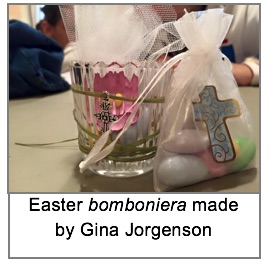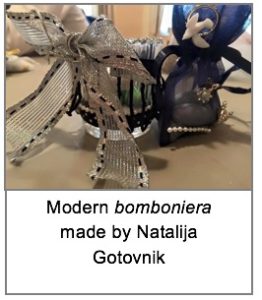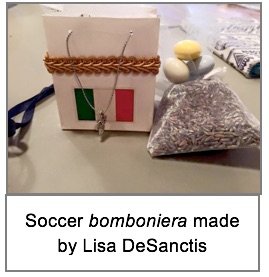Even if you were not able to attend the workshop during the 2015 conference, you can partially share the experience through this handout which participants received. Workshop attendees followed a PowerPoint presentation on the  history and production of bomboniere and then used a variety of materials to create bomboniere of their own.
history and production of bomboniere and then used a variety of materials to create bomboniere of their own.
— Jackie Capurro, San Jose, CA
Locations Mentioned during the Presentation
- Sulmona: a city and comune of the province of L’Aquila in the Abruzzo region, east of Rome, the home of widely-known manufacturers of confetti
- Museo dell’Arte e della Tecnologia Confettiere Pelino (Pelino Museum of Confetti Art and Technology) is located in the Pelino Factory in Sulmona and contains displays of the history and production of confetti.
Website: <http://confettimariopelino.com/museo/> - Avola: a small town in Sicily, between Siracusa and Ragusa, known for growing high-quality almonds, perfectly shaped for confetti
Definitions
- bomboniera (plural: bomboniere) = favor
- bonbonnière = original French for bomboniere
- bon-bons = French candies
- confetto (plural: confetti) = confection, in this case referring to sugar-covered almonds used to make bomboniere

- torrone = a honey and almond nougat candy, a specialty of Siena and the Tuscany region, but found throughout Italy
- croccante = almonds (or other nuts) hardened in honey, similar to our peanut brittle
- coppa amatoria = ‘loving cup’ painted ceramic wide-bowled cup given by men to their betrothed in 15th century Italy
- jardin = garden in French, possibly the origin of the word for Jordan almonds
- bassine = the large copper (or steel) drums in which the almonds receive their sugar coating
- Ministero delle politiche agricole, alimentari e forestali = Italian Ministry of Agriculture, Food, and Forestry
- A.T. (Prodotto agroalimentare tradizionale) = Traditional Agricultural Product, an official approval for traditional Italian regional food products marketed abroad
- battesimo = baptism
- prima comunione = first communion
- cresima = confirmation
- laurea = graduation
- fidanzamento = engagement
- nozze (or: matrimonio) = wedding
- salute, fertilità, lunga vita (or: longevità), felicità, e richezza = health, fertility, long life (or: longevity), happiness, and wealth (riches). These are the five qualities of life wished for the newlyweds, represented by the five confetti in each wedding bomboniera
- torta di bomboniere = ‘cake’ fashioned with bomboniere
Summary
The tradition of giving small favors or gifts at major life events has evolved from ancient times as a result of custom, society, and available materials.  Confetti as we know them now evolved from earlier forms of honeyed almonds to the sugar-coated almonds after sugar became readily available and affordable in the 15th century, when confetti were known to be produced in Sulmona and, later, sewn into floral formations by the nuns in Sulmona’s Convent of Santa Chiara.
Confetti as we know them now evolved from earlier forms of honeyed almonds to the sugar-coated almonds after sugar became readily available and affordable in the 15th century, when confetti were known to be produced in Sulmona and, later, sewn into floral formations by the nuns in Sulmona’s Convent of Santa Chiara.
These creations only became known as bomboniere in the 18th century, when the tradition of exchanging elegant boxes filled with candies became the fashion in France and Italy, and eventually became a tradition amongst the commoners as well.
Confetti in Sulmona are usually made from Sicilian Avola almonds, prized for their shape and flavor. The almonds are coated by rotating them for hours in large copper boilers called bassine. The Confetti di Sulmona are recognized by the Italian Ministry of Agriculture, Food, and Forestry on their list of traditional Italian food products for international marketing purposes.
Bomboniere are shared at major family events. In Italy, these are most often religious in nature, related to the Catholic Sacraments, as well as major life events, so you will find them at baptisms, first communion, confirmation, graduations, engagements, weddings, milestone anniversaries, and sometimes birthdays. They may be used as placeholders for the guests, distributed by the honorees, or fashioned into a Torta di Bomboniere, resembling a large wedding cake where each “slice” is an individual bomboniera. Bomboniere can range from very simple bags of confetti, tied with ribbons and decorated with small charms, to elegant creations where small bags of confetti may be attached to expensive figurines or plates of silver, crystal or ceramic. Modern couples often choose to provide their guests with more practical bomboniere attached to small kitchen utensils, photo frames, corkscrews, wine stoppers, or cheese graters.
Traditionally, confetti are used in odd numbers (5, 3, or 1) to fashion a bomboniera. Five-petaled flowers, especially, are given at weddings to symbolize health, fertility, long life, happiness, and wealth.
The color of the confetti (and often the ribbon) will depend on the occasion.

In addition, each landmark marriage anniversary year has its own color of confetti:
